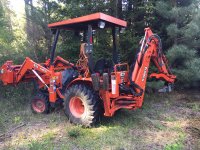K5lwq
Elite Member
- Joined
- Aug 6, 2017
- Messages
- 4,917
- Location
- Mineola, TX
- Tractor
- Kioti LK2554, Branson 4815C, Satoh Beaver, Speedex
Looks like you already have a very good assortment of implements to take on this task - to which a grapple and/or pallet fork could be useful additions, and there's already been a fair amount of good advice provided so I'll attempt to keep my thoughts short, and content rich.
Pallet forks work well for trees and large pieces of wood. However, they don't work as well as a grapple when it comes to lots of smaller pieces, or things where it's harder to locate the balance point (e.g. shrubs with a root ball attached that's still shedding dirt). I started with pallet forks and quickly bought a grapple because of the additional control it has over objects being carried. So I'd say being able to use equipment to carry things in a controlled manner always beats moving things by hand. ....whereas I'm not so sure I'd say that's always the case when it comes to using equipment to move things that aren't/can't be controlled by the equipment.
When it comes to root removal both a grapple and a box blade have their use. The grapple can rake through the ground, but the front wheels may come off the ground due to how tractor loader arms are attached to the tractor.... much like when digging with a tractor. However a box blade plays to a tractor's strengths in that at the more it loads up the more it drives the rear wheels into the ground which increases traction. Personally I prefer to use a box blade to build windrows of roots, and use the grapple to pickup the windrow.
Pushing over trees can be done, though it's not risk free and does requires attention to detail, along with using leverage for the best results. Use the trunk as a lever to find where the roots are, and then push the tree toward the longest roots. For the sake of safety you'll want to avoid snapping the trunk -- especially if your front wheels end up off the ground (as has already been noted tractor loaders aren't really optimized for pushing/digging, and weird/undesirable things can happen when loaded up too much). Once the tree is over use the root ball like a "wheel" with the trunk as the "axle" to break/remove the remaining roots. Using an approach like that can permit removal of trees larger than the use of shear brute force alone. With proper techniques the size of the tree matters less than the type of tree, it's root structure, and the soil type (along with it's moisture content).
Of course, since you have a backhoe that can also help locate/break roots as backhoes on tractors will typically be able to generate higher break out forces (from what I've seen anyway) along with having narrower buckets to concentrate that force in a smaller area.
So yes, I'd say it's very feasible it's just a case of being patient, paying attention to what is happening when you're working, and not using speed/brute force (e.g. ramming, jerking, etc) to force things to happen.
In all reality that adage of "slow is smooth smooth is fast" is also very applicable to operating heavy machinery.
Just my :2cents: ...which admittedly may not be worth even that much.
Well said!
No matter the tools you have or use, learn to use them properly. I have cleared a lot of ground with a axe, swing blade, kaiser blade and a pick axe. All cheaper and less maintenance than a chain saw, tractor, front loader, bucket, grapple or forks.
I use my grapple more than my forks. I use my forks more than my bucket. Before I had a loader, I found ways to do everything I needed to do with just a bare tractor. Before I got a grapple and forks, I could not imagine life without the bucket. I have not used the bucket in over a year now. You learn to use the best tool in your arsenal for the task at hand.


